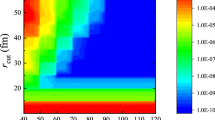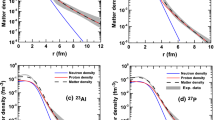Abstract
In this paper, we presented an elegant theoretical scheme to investigate the bound and resonance states in the \(^{19}\)C halo nucleus. The nucleus \(^{19}\)C being weakly bound one-neutron halo, can be treated as a two-body system consisting of the \(^{18}\)C core plus one outer core valence neutron. An effective core-nucleon potential is derived by folding a phenomenological nucleon-nucleon potential into the density distribution of the core nucleus. The two-body Schrödinger equation for the effective core-nucleon potential is solved to find the energies and wave functions of the bound states. The wave functions so obtained are used to construct a one-parameter family of isospectral potentials by the application of supersymmetric quantum mechanics. The newly constructed isospectral potentials are used in the Schrödinger equation to compute the resonant states. The calculated results are in excellent agreement with their corresponding observed values as found in the literature.








Similar content being viewed by others
References
G. Audi, O. Bersillon, J. Blachot, A.H. Wapstra, The NUBASE evaluation of nuclear and decay properties. Nucl. Phys. A 729, 3 (2003)
B. Acharya, C. Ji, D.R. Phillips, Implications of a matter-radius measurement for the structure of Carbon-22. Phys. Lett. B 723, 196 (2013)
I. Tanihata et al., Measurements of interaction cross sections and nuclear radii in the light p-shell region. Phys. Rev. Lett. 55, 2676 (1985)
N. Michel et al., Two-neutron halo structure of \(^{31}\)F. Phys. Rev. C 101, 031301(R) (2020)
J. Singh et al., Exploring two-neutron halo formation in the ground state of \( ^{29} \)F within a three-body model. Phys. Rev. C 101, 024310 (2020)
K.P. Anjali et al., Studies on the existence of various 1p, 2p Halo isotopes via cluster decay of nuclei in superheavy region. Braz. Jour. Phys. 50, 71 (2020)
M. Stanoiu et al., Study of drip-line nuclei through two-step fragmentation. Eur. Phys. J. A 20, 95 (2004)
T. Yamaguchi, K. Tanaka et al., Nuclear reactions of \( ^{19,20} \)C on a liquid hydrogen target measured with the superconducting TOF spectrometer. Nucl. Phys. A 864, 1 (2011)
J.M. Bang et al., Few-body aspects of Borromean halo nuclei. Phys. Rep. 264, 27 (1996)
P. Banerjee, J.A. Tostevin, I.J. Thompson, Coulomb breakup of two-neutron halo nuclei. Phys. Rev. C 58, 1337 (1998)
M. Brodeur et al., First direct mass measurement of the two-neutron halo nucleus \( ^{6} \)He and improved mass for the four-neutron halo \( ^{8} \)He. Phys. Rev. Lett. 108, 052504 (2012)
Z. Ren, B. Chen, G. Xu, Z. Ma, W. Mittig, Structure of halo nuclei \(^{14}\)Be and \(^{32}\)Ne. Phys. Lett. B 351, 11 (1995)
K. Tanaka et al., Observation of a large reaction cross section in the drip-line nucleus \( ^{22} \)C. Phys. Rev. Lett. 104, 062701 (2010)
N. Kobayashi et al., One-and two-neutron removal reactions from the most neutron-rich carbon isotopes. Phys. Rev. C 86, 054604 (2012)
L. Gaudefroy et al., Direct mass measurements of \( ^{19} \)B, \( ^{22} \)C, \( ^{29} \)F, \( ^{31} \)Ne, \( ^{34} \)Na and other light exotic nuclei. Phys. Rev. Lett. 109, 202503 (2012)
Y. Togano et al., Interaction cross-section study of the two-neutron halo nucleus \( ^{22} \)C. Phys. Lett. B 761, 412 (2016)
Z. Ren, B. Chen, Z. Ma, G. Xu, One-proton halo in \( ^{26} \)P and two-proton halo in \( ^{27} \)S. Phys. Rev. C 53, R572(R) (1996)
A.A. Ibraheem, A.S. Hajjaji, M.E. Farid, Elastic scattering of one-proton halo nucleus \( ^{17} \)F on different mass targets using semi microscopic potentials. Rev. Mex. Fis. 65, 168 (2019)
W.S. Hwash, Study of the two-proton halo nucleus \( ^{17} \)Ne. Int. J. Mod. Phys E 25, 1650105 (2016)
B. Gönül, M. Yilmaz, Halo structure of \( ^{19} \)C via the (p, d) reaction. Few-Body Syst. 30, 211 (2001)
E.K. Warburton, B.A. Brown, Effective interactions for the 0p1s0d nuclear shell-model space. Phys. Rev. C 46, 923 (1992)
D. Ridikas et al., 19-C: the heaviest one-neutron halo nucleus? Eur. Phys. Lett. 37, 385 (1997)
D. Ridikas et al., Exploratory coupled channels calculations for loosely bound carbon isotopes. Nucl. Phys. A 628, 363 (1998)
J.D. Bowman, A.M. Poskanzer, R.G. Korteling, G.W. Butler, Detection of neutron-excess isotopes of low-Z elements produced in high-energy nuclear reactions. Phys. Rev. C 9, 836 (1974)
M. Thoennessen, Discovery of isotopes with Z\( \le \)10. At. Data Nucl. Data Tables 98, 43 (2012)
T. Tarutina, A.R. Samana, F. Krmpotic, M.S. Hussein, Quasiparticle-rotor model description of carbon isotopes. Braz. J. Phys. 36, 1349 (2006)
T. Nakamura et al., Coulomb dissociation of \( ^{19} \)C and its halo structure. Phys. Rev. Lett. 83, 1112 (1999)
V. Maddalena et al., Single-neutron knockout reactions: application to the spectroscopy of \( ^{16,17,19} \)C. Phys. Rev. C 63, 024613 (2001)
C. Yuan, T. Suzuki, T. Otsuka, F. Xu, N. Tsunoda, Shell-model study of boron, carbon, nitrogen, and oxygen isotopes with a monopole-based universal interaction. Phys. Rev. C 85, 064324 (2012)
M. Stanoiu et al., Disappearance of the N=14 shell gap in the carbon isotopic chain. Phys. Rev. C 78, 034315 (2008)
Z. Elekes et al., Low-lying excited states in \(^{17,19} \)C. Phys. Lett. B 614, 174 (2005)
A. Ozawa et al., One- and two-neutron removal reactions from \( ^{19,20} \)C with a proton target. Phys. Rev. C 84, 064315 (2011)
Y. Satou et al., Unbound excited states in \( ^{19,17} \)C. Phys. Lett. B 660, 320 (2008)
M. Thoennessen et al., Observation of a low-lying neutron-unbound state in \( ^{19} \)C. Nucl. Phys. A 912, 1 (2013)
A. Csótó, Proton skin of \( ^{8} \)B in a microscopic model. Phys. Lett. B 315, 24 (1993)
A. Csótó, Neutron halo of \( ^{6} \)He in a microscopic model. Phys. Rev. C 48, 165 (1993)
A. Csótó, Three-body resonances in \(^{6}\)He, \(^{6} \)Li and \(^{6}\)Be and the soft dipole mode problem of neutron halo nuclei. Phys. Rev. C 49, 3035 (1994)
S. Aoyama, S. Mukai, K. Kato, K. Ikeda, Theoretical predictions of low-lying three-body resonance states in \( ^{6} \)He. Prog. Theor. Phys. 94, 343 (1995)
A. Cobis, D.V. Fedorov, A.S. Jensen, Computations of Three-body continuum spectra. Phys. Rev. Lett. 79, 2411 (1997)
A. Cobis, D.V. Fedorov, A.S. Jensen, Three-body halos. V. Computations of continuum spectra for Borromean nuclei. Phys. Rev. C 58, 1403 (1998)
N. Tanaka, Y. Suzuki, K. Varga, Exploration of resonances by analytic continuation in the coupling constant. Phys. Rev. C 56, 562 (1997)
B.V. Danilin, T. Rogde, S.N. Ershov, H. Heiberg-Andersen, J.S. Vaagen, I.J. Thompson, M.V. Zhukov, New modes of halo excitation in the \( ^{6} \)He nucleus. Phys. Rev. C 55, R577 (1997)
V. Vasilevsky, A.V. Nesterov, F. Arickx, J. Broeckhove, Algebraic model for scattering in three-s-cluster systems. II. Resonances in the three-cluster continuum of \( ^{6} \)He and \( ^{6} \)Be. Phys. Rev. C 63, 034607 (2001)
K. Ogata, T. Myo, T. Furumoto, T. Matsumoto, M. Yahiro, Interplay between the \( 0^{+}_{2} \) resonance and the nonresonant continuum of the drip-line two-neutron halo nucleus \( ^{22} \)C. Phys. Rev. C. 88, 024616 (2013)
M. Hasan, T. Surungan, Md.A. Khan, Construction of a one-parameter family of isospectral potential to study resonances in weakly bound halo nuclei. J. Phys. Conf. Ser. 1354, 012003 (2019)
F. Cooper, A. Khare, U. Sukhatme, Supersymmetry and quantum mechanics. Phys. Rep. 251, 267 (1995)
A. Khare, U. Sukhatme, Phase-equivalent potentials obtained from supersymmetry. J. Phys. A Math. Gen. 22, 2847 (1989)
M.M. Nieto, Relationship between supersymmetry and the inverse method in quantum mechanics. Phys. Lett. B 145, 208 (1984)
B.R. Johnson, The renormalized Numerov method applied to calculating bound states of the coupled channel Schröedinger equation. J. Chem. Phys. 69, 4678 (1978)
G. Darboux, On a proposition relative to linear equations. C. R. Acad. Sci. Paris 94, 1456 (1882)
J. Pappademos, U. Sukhatme, A. Pagnamenta, Bound states in the continuum from supersymmetric quantum mechanics. Phys. Rev. A 48, 3525 (1993)
M. A. Preston and R. K. Bhaduri, Structure of the Nucleus, Westview Press (1975) p-509 (Chapter-11); p-660 (Appendix D)
A.J. Toubiana, L.F. Canto, M.S. Hussein, Approximate transmission coefficients in heavy ion fusion. Braz. J. Phys. 47, 321 (2017)
L. Gan et al., Parametrization of woods-saxon potential for heavy-ion systems. Sci. China-Phys. Mech. Astron. 60, 082013 (2017)
J. Dudek, Z. Szymanski, T. Werner, Woods-Saxon potential parameters optimized to the high spin spectra in the lead region. Phys. Rev. C 23, 920 (1981)
T.K. Das, B. Chakrabarti, Calculation of resonances using isospectral potentials. Phys. Letts. A 288, 4 (2001)
S.K. Dutta, T.K. Das, M.A. Khan, B. Chakrabarti, Computation of 2\( ^{+} \) resonance in \( ^{6} \)He: bound state in the continuum. J. Phys. G Nucl. Part. Phys. 29, 2411 (2003)
S.K. Dutta, T.K. Das, M.A. Khan, B. Chakrabarti, Calculation of resonances in weakly bound systems. Int. J. Mod. Phys. E. 13, 811 (2004)
S. Mahapatra, Low-lying resonance State of \(^{15}\)C: application of supersymmetric quantum mechanics. Few-Body Syst. 52, 1 (2012)
S.K. Dutta, D. Gupta, D. Das, S.K. Saha, Study of resonance states of \(^{11}\)Be with isospectral bound state microscopic potential. J. Phys. G: Nucl. Part. Phys. 41, 095104 (2014)
S.K. Dutta, D. Gupta, S.K. Saha, Resonance state wave functions of \(^{15}\)Be using supersymmetric quantum mechanics. Phys. Lett. B 776, 464 (2018)
G. Audi, A.H. Wapstra, C. Thibault, The AME2003 atomic mass evaluation:(II). Tables, graphs, and references. Nucl. Phys. A 729, 337 (2003)
M. Wang, G. Audi, A.H. Wapstra, F.G. Kondev, M. MacCormick, X. Xu, B. Pfeiffer, The Ame 2012 atomic mass evaluation. Chinese Phys. C 36, 1603 (2012)
J.W. Hwang et al., Single-neutron knockout from \( ^{20} \)C and the structure of \( ^{19} \)C. Phys. Lett. B 769, 503 (2017)
A.R. Ridha, Z.M. Abbas, Study of matter density distributions, elastic charge form factors, and size radii for halo \(^{11}\)Be, \(^{19}\)C and \(^{11}\)Li nuclei. Iraqi J. Phys. 16, 29 (2018)
R. Kanungo et al., Proton distribution radii of \( ^{12-19}\)C illuminate features of neutron halos. Phys. Rev. Lett. 117, 102501 (2016)
Acknowledgements
This work has been supported by a computational facility at Aliah University, India.
Author information
Authors and Affiliations
Corresponding author
Additional information
Publisher's Note
Springer Nature remains neutral with regard to jurisdictional claims in published maps and institutional affiliations.
Rights and permissions
About this article
Cite this article
Khan, M.A., Hasan, M., Mondal, S.H. et al. Application of Supersymmetric Quantum Mechanics to Calculate Resonance Energy and Wave Function of \(^{19}\)C Halo Nucleus. Few-Body Syst 62, 54 (2021). https://doi.org/10.1007/s00601-021-01640-1
Received:
Accepted:
Published:
DOI: https://doi.org/10.1007/s00601-021-01640-1




